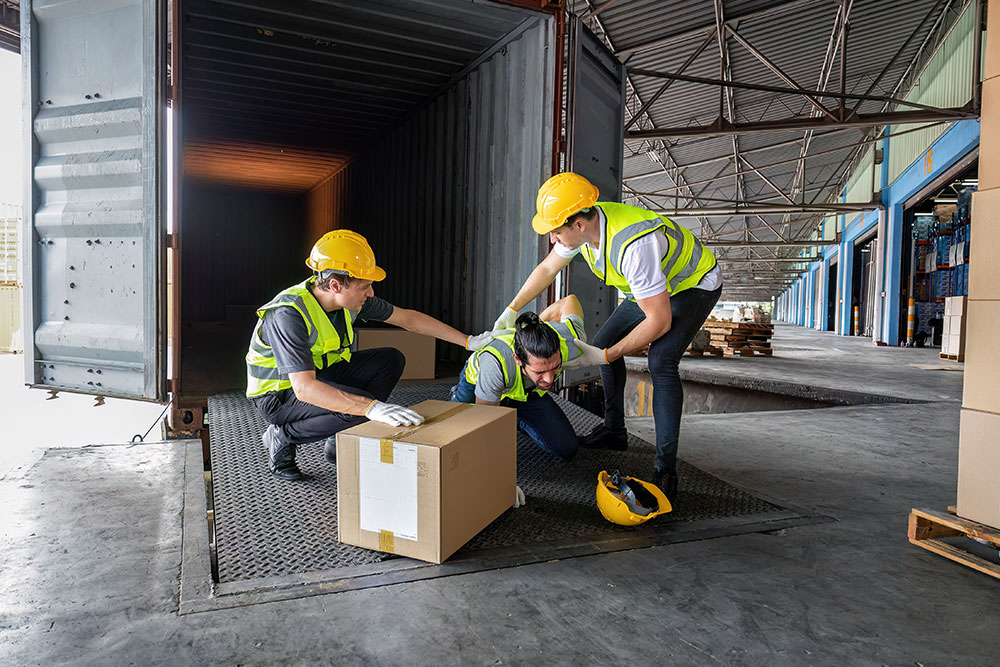
Manual handling is a leading cause of non-fatal injuries in the workplace. It’s held this position for many years despite laws existing to protect workers. So, what legislation applies to manual handling in the UK?
Our guide runs down the three primary pieces of legislation that apply to all manual handling work. It summarises what you need to do as an employer or employee to comply and prevent the all-too-common aches, strains and back pain caused by unsafe manual handling in the workplace.
Understanding What Legislation Applies to Manual Handling in the UK
There are three pieces of legislation relevant to all manual handling in the UK. We’ve listed them below and outlined what you must do to comply.
The Health and Safety at Work etc. Act 1974
When asking, “What legislation applies to manual handling in the UK?” the first answer is The Health and Safety at Work etc. Act 1974 (the HSWA). In fact, the HSWA would be the first answer when searching for legislation related to any type of work activity because it’s the foundation for British health and safety law.
The HSWA imposes a legal duty on employers to ensure a safe working environment and prevent their work activities from harming employees or members of the public. It also requires employees to cooperate with their employers on health and safety matters and take reasonable steps to protect their and others’ wellbeing while working.
Although the HSWA doesn’t specifically refer to any form of work, it’s relevant to everything that happens in your workplace, including manual handling.
However, you won’t find practical advice in the HSWA. To ensure your work activities are safe, you’ll need to comply with the relevant regulations passed in support of workplace safety. It’s these regulations that detail what you must do as an employer or employee to prevent harm while supervising or undertaking workplace manual handling tasks.
Manual Handling Training
Our Manual Handling training course helps users ensure that they are sufficiently trained in the principles and practices of safe manual handling to control and minimise manual handling-related injuries and to ensure a safe workplace for all.
The Management of Health and Safety at Work Regulations 1999
Like the HSWA, every discussion of UK health and safety law must also include the Management of Health and Safety at Work Regulations 1999 (the Management Regulations).
The Management Regulations set out your most important duties when it comes to workplace health and safety. They make it a requirement for employers to:
- risk assess all work activities;
- eliminate or control identified risks;
- appoint a competent person or persons to oversee workplace health and safety.
Again, the Management Regulations make no specific reference to manual handling, but any work must be risk assessed by a competent person. (Competent means they have the right combination of knowledge, experience, and training to do the job safely.)
So, before any work activity can happen, someone competent must have done the following:
- identified all hazards that may cause harm;
- evaluated the likelihood of harm happening and how severe it will be (the risk);
- advised on how to eliminate or control the risks to a ‘reasonably practicable’ level.
The employer must then implement these control measures, provided the effort and cost of doing so matches the level of risk (this is what ‘reasonably practicable’ means).
If your general risk assessment finds risks related specifically to manual handling, you must also comply with the Manual Handling Operations Regulations 1992.
The Manual Handling Operations Regulations 1992
As the name suggests, the Manual Handling Operations Regulations 1992 (MHOR) set out what employers and employees must do to make manual handling in the workplace safe.
MHOR establishes a three-part framework for making manual handling safe:
- Avoid manual handling activities if possible
- Assess the risks of unavoidable manual handling
- Reduce those risks to safe levels
You must follow this framework in order for all manual handling activities. We’ve outlined each step below.
1. Avoid Manual Handling
First, determine if loads must actually be moved.
It’s sometimes possible to redesign tasks to eliminate the need for manual or mechanical lifting. For example, you could arrange for materials to be delivered directly to the location they’ll be used.
If this isn’t feasible, consider ways to avoid manual handling. Can systems be mechanised or automated, as in production lines?
If it’s too costly or impossible to retrofit existing systems, can you provide mechanical lifting aids to employees? Trucks, trolleys, hoists – there’s a wide range of tools your employees can use to eliminate the need to use bodily force.
If you do provide mechanical lifting aids, you must train your workers to use them safely. These aids also count as workplace equipment, meaning they’re subject to the Provision and Use of Workplace Equipment Regulations 1998 (PUWER).

2. Assess the Risks
If manual handling is too costly or prohibitive to avoid entirely, you need to determine how to make it safe. This process starts with a risk assessment of the manual handling task.
A manual handling risk assessment follows the same structure as a general work risk assessment. Someone competent must:
- identify the hazards;
- evaluate the risks;
- implement control measures.
To be sufficient, a manual handling risk assessment must consider:
- the task;
- the load;
- the workplace;
- the individual capacity of the lifter (i.e. their ability to physically move a load and knowledge of safe manual handling);
- how manual handling tasks are allocated;
- the pace, frequency and duration of the task.
For simple manual handling tasks, the risk assessment process is straightforward. For more complex assessments, you may find the HSE’s manual handling assessment tools useful. The HSE provides:
- Manual Handling Assessment Charts (MAC) for lifting, carrying and team manual handling
- Variable Manual Handling Assessment Charts (V-MAC) for more complex tasks
- The Risk Assessment of Pushing and Pulling (RAPP) tool
- The Assessment of Repetitive Tasks (ART) tool
It’s also necessary to involve workers in the risk assessment process. Frontline staff have intimate knowledge of manual handling risks and can help ensure that control measures are practical and effective.
3. Reducing the Risks
There’s no set procedure for making manual handling safe; your control measures should address the unique risks detailed in your assessment. However, there are common factors to consider. We’ve explored these factors and ways to improve safety below.
The Task
Certain actions, like twisting or stooping, greatly increase injury risks. As does lifting a load above shoulder height. Carrying loads over long distances or repeating movements also invites injury.
Provide training on safe lifting techniques to reduce these risks. You can also vary work patterns, so staff have opportunities to rest between rounds of manual handling.
The Load
Handling heavy or bulky loads is more likely to result in injury. Loads that are difficult or painful to grip can also cause harm.
Reduce or separate loads so they’re lighter and easier to move. Team manual handling is another possible solution when objects are too much for one person. Handles or straps should also be used when there’s no safe place to grip the load.
The Work Environment
Slipping and tripping hazards obviously increase manual handling risks. Navigating these obstacles might also force workers to adopt an unsafe lifting position or extend the task’s duration.
Plan around stairs, steps, narrow corridors, low ceilings or any other physical features that’ll make manual handling more difficult. Also, consider slip and trip hazards and how they can be managed.

Individual Capacity
While there are no weight limits for manual handling tasks, workers must be capable of safely lifting loads. Consider strength levels and other limiting factors, such as physical disabilities or existing health problems. Experience also plays a part; novice lifters are unsuited for strenuous manual handling work.
Ensure that all workers are fit and able to meet the task’s demands. It’s also necessary to provide employees with training and instruction matched to the actual manual handling activities they’re performing.
Training
Training is always required to make manual handling safe. Under MHOR, employers must provide appropriate training, and employees must apply it.
Our online Manual Handling course is designed for all workers who undertake manual handling activities in their daily work. It teaches users how to assess manual handling hazards and use safe lifting techniques to minimise the risk of injury while working.
It also recaps what legislation applies to manual handling in the UK so both employers and employees understand their manual handling duties and how to comply.





















